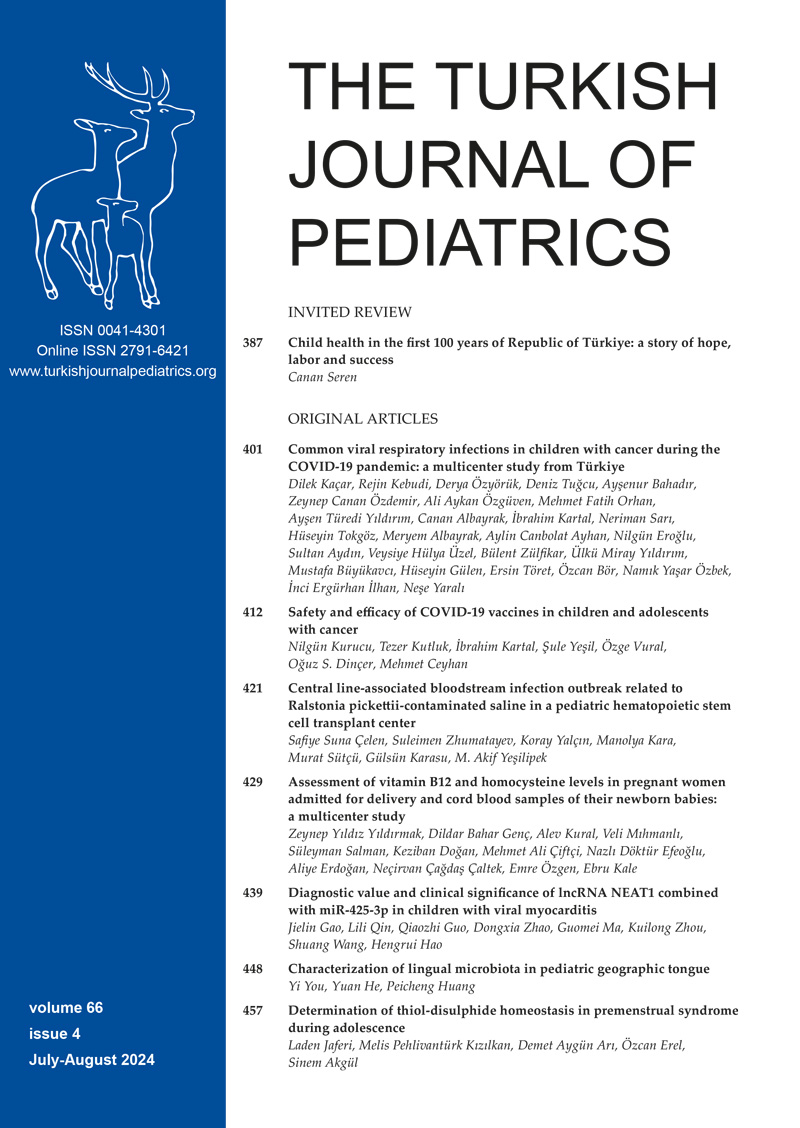Abstract
Background. Ralstonia pickettii is an aerobic Gram-negative non-fermentative bacillus. It is an opportunistic pathogen that has recently prompted nosocomial outbreaks. Although it has low virulence, it can cause a wide range of invasive diseases in immunosuppressive patients. The characteristics of R. pickettii-related central line-associated bloodstream infection (CLABSI) outbreak in pediatric hematopoietic stem cell transplant (HSCT) recipients are presented in this study.
Materials and Methods. This was a single-center, retrospective analysis conducted at Bahcesehir University Goztepe Medicalpark Hospital . The clinical and laboratory characteristics of twelve children with Ralstonia-related CLABSIs were analyzed.
Results. Of the twelve patients with R. pickettii growth, seven were female. The median age was 12.1 (2-17) years. Autologous HSCT was performed in two of the patients and allogeneic HSCT was performed in ten patients for both malignant and non-malignant diseases. In the conditioning regimens, all patients were given myeloablative therapy. Clinical sepsis was the most common presentation. As a result of the investigations, R. pickettii growth was observed in saline solutions. All cases were successfully treated with the appropriate antibiotic regimen and the bacteria was not found in repeat cultures. Catheter removal was required in two patients. Mortality was not observed in any patient as the outcome of the infection episode.
Conclusion. The detection and control of the infectious source are critical in pediatric HSCT patients with severe immunosuppression, as medical equipment-related outbreaks can be life-threatening.
Keywords: Ralstonia pickettii, stem cell transplantation, child, outbreak, infectious disease
References
- Ryan MP, Adley CC. Ralstonia spp.: emerging global opportunistic pathogens. Eur J Clin Microbiol Infect Dis 2014; 33: 291-304. https://doi.org/10.1007/s10096-013-1975-9
- Falcone-Dias MF, Vaz-Moreira I, Manaia CM. Bottled mineral water as a potential source of antibiotic resistant bacteria. Water Res 2012; 46: 3612-3622. https://doi.org/10.1016/j.watres.2012.04.007
- Szymańska J. Bacterial decontamination of DUWL biofilm using Oxygenal 6. Ann Agric Environ Med 2006; 13: 163-167.
- Kendirli T, Ciftçi E, Ince E, et al. Ralstonia pickettii outbreak associated with contaminated distilled water used for respiratory care in a paediatric intensive care unit. J Hosp Infect 2004; 56: 77-78. https://doi.org/10.1016/j.jhin.2003.09.011
- Kulakov LA, McAlister MB, Ogden KL, Larkin MJ, O'Hanlon JF. Analysis of bacteria contaminating ultrapure water in industrial systems. Appl Environ Microbiol 2002; 68: 1548-1555. https://doi.org/10.1128/AEM.68.4.1548-1555.2002
- Degeorges R, Teboul F, Belkheyar Z, Oberlin C. Ralstonia pickettii osteomyelitis of the trapezium. Chir Main 2005; 24: 174-176. https://doi.org/10.1016/j.main.2005.04.007
- Bonatti H, Stelzmueller I, Laimer I, Obwegeser A. Ralstonia pickettii meningitis in a child with hydrocephalus. Eur J Pediatr Surg 2009; 19: 341-342. https://doi.org/10.1055/s-0029-1202252
- Kismet E, Atay AA, Demirkaya E, et al. Two cases of Ralstonia pickettii bacteremias in a pediatric oncology unit requiring removal of the Port-A-Caths. J Pediatr Hematol Oncol 2005; 27: 37-38. https://doi.org/10.1097/01.mph.0000149960.89192.b0
- Timm WD, Pfaff SJ, Land GL, et al. An outbreak of multi-drug resistant Pseudomonas pickettii pneumonia in a neonatal intensive care unit. In: Proceedings of the 35th Interscience Conference on Antimicrobial Agents and Chemotherapy (ICAAC). 1995; 49.
- Ryan MP, Adley CC. The antibiotic susceptibility of water-based bacteria Ralstonia pickettii and Ralstonia insidiosa. J Med Microbiol 2013; 62: 1025-1031. https://doi.org/10.1099/jmm.0.054759-0
- McDonald MK, Culos KA, Gatwood KS, et al. Defining incidence and risk factors for catheter-associated bloodstream infections in an outpatient adult hematopoietic cell transplantation program. Biol Blood Marrow Transplant 2018; 24: 2081-2087. https://doi.org/10.1016/j.bbmt.2018.04.031
- Bedir Demirdag T, Ozkaya-Parlakay A, Bayrakdar F, et al. An outbreak of Ralstonia pickettii bloodstream infection among pediatric leukemia patients. J Microbiol Immunol Infect 2022; 55: 80-85. https://doi.org/10.1016/j.jmii.2020.12.004
- Horan TC, Andrus M, Dudeck MA. CDC/NHSN surveillance definition of health care-associated infection and criteria for specific types of infections in the acute care setting. Am J Infect Control 2008; 36: 309-332. https://doi.org/10.1016/j.ajic.2008.03.002
- Santos VM. To: Ralstonia pickettii bacteremia in hemodialysis patients: a report of two cases. Rev Bras Ter Intensiva 2016; 28: 488-489. https://doi.org/10.5935/0103-507X.20160082
- Fluit AC, Bayjanov JR, Aguilar MD, et al. Characterization of clinical Ralstonia strains and their taxonomic position. Antonie Van Leeuwenhoek 2021; 114: 1721-1733. https://doi.org/10.1007/s10482-021-01637-0
- Gardner S, Shulman ST. A nosocomial common source outbreak caused by Pseudomonas pickettii. Pediatr Infect Dis 1984; 3: 420-422. https://doi.org/10.1097/00006454-198409000-00006
- Zhang L, Morrison M, Rickard CM. Draft genome sequence of Ralstonia pickettii AU12-08, isolated from an intravascular catheter in Australia. Genome Announc 2014; 2: e00027-14. https://doi.org/10.1128/genomeA.00027-14
- Kimura AC, Calvet H, Higa JI, et al. Outbreak of Ralstonia pickettii bacteremia in a neonatal intensive care unit. Pediatr Infect Dis J 2005; 24: 1099-1103. https://doi.org/10.1097/01.inf.0000190059.54356.f3
- Ross B, Steinmann J, Buer J, et al. Outbreak with Ralstonia pickettii caused by contaminated magnesium vials. Dtsch Med Wochenschr 2014; 139: 323-326. https://doi.org/10.1055/s-0033-1360059
- Choudhury H, Jindal A, Pathengay A, Flynn HW. An outbreak of Ralstonia pickettii endophthalmitis following intravitreal methotrexate injection. Clin Ophthalmol 2015; 9: 1117-1120. https://doi.org/10.2147/OPTH.S81218
- Costas M, Holmes B, Sloss LL, Heard S. Investigation of a pseudo-outbreak of 'Pseudomonas thomasii' in a special-care baby unit by numerical analysis of SDS-PAGE protein patterns. Epidemiol Infect 1990; 105: 127-137. https://doi.org/10.1017/s0950268800047725
- Girlich D, Naas T, Nordmann P. OXA-60, a chromosomal, inducible, and imipenem-hydrolyzing class D beta-lactamase from Ralstonia pickettii. Antimicrob Agents Chemother 2004; 48: 4217-4225. https://doi.org/10.1128/AAC.48.11.4217-4225.2004
- Celebi S, Sezgin ME, Cakır D, et al. Catheter-associated bloodstream infections in pediatric hematology-oncology patients. Pediatr Hematol Oncol 2013; 30: 187-194. https://doi.org/10.3109/08880018.2013.772683
- Eggimann P, Sax H, Pittet D. Catheter-related infections. Microbes Infect 2004; 6: 1033-1042. https://doi.org/10.1016/j.micinf.2004.05.018
- Gaynes R, Jacob JT. Intravascular catheter-related infection: epidemiology, pathogenesis, and microbiology. Available at: https://www.uptodate.com (Accessed on Aug 2022).
- Aksoy BA, Kara M, Sütçü M, et al. Epidemiologic and microbiologic evaluation of catheter-line bloodstream infection in a pediatric hematopoietic stem cell transplant center. Am J Infect Control 2024; 52: 81-86. https://doi.org/10.1016/j.ajic.2023.08.010
Copyright and license
Copyright © 2024 The Author(s). This is an open access article distributed under the Creative Commons Attribution License (CC BY), which permits unrestricted use, distribution, and reproduction in any medium or format, provided the original work is properly cited.















